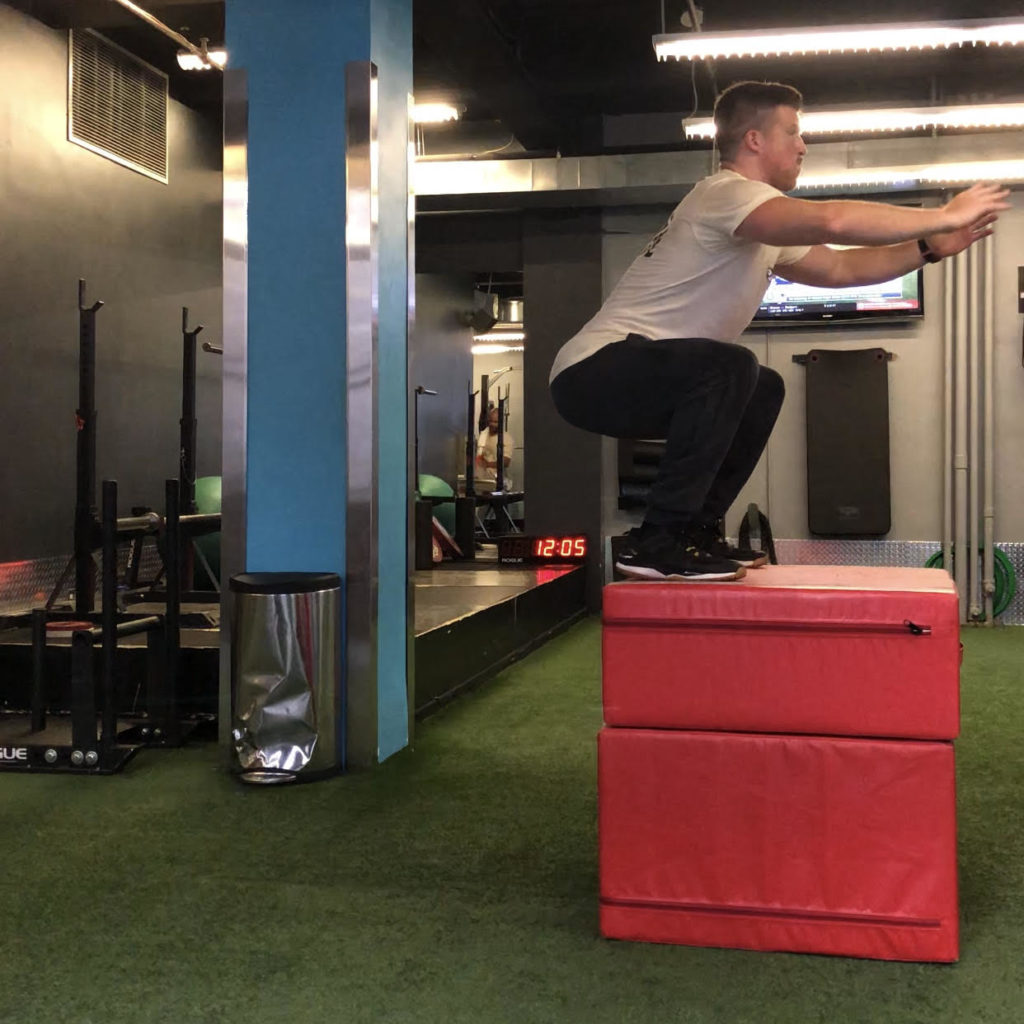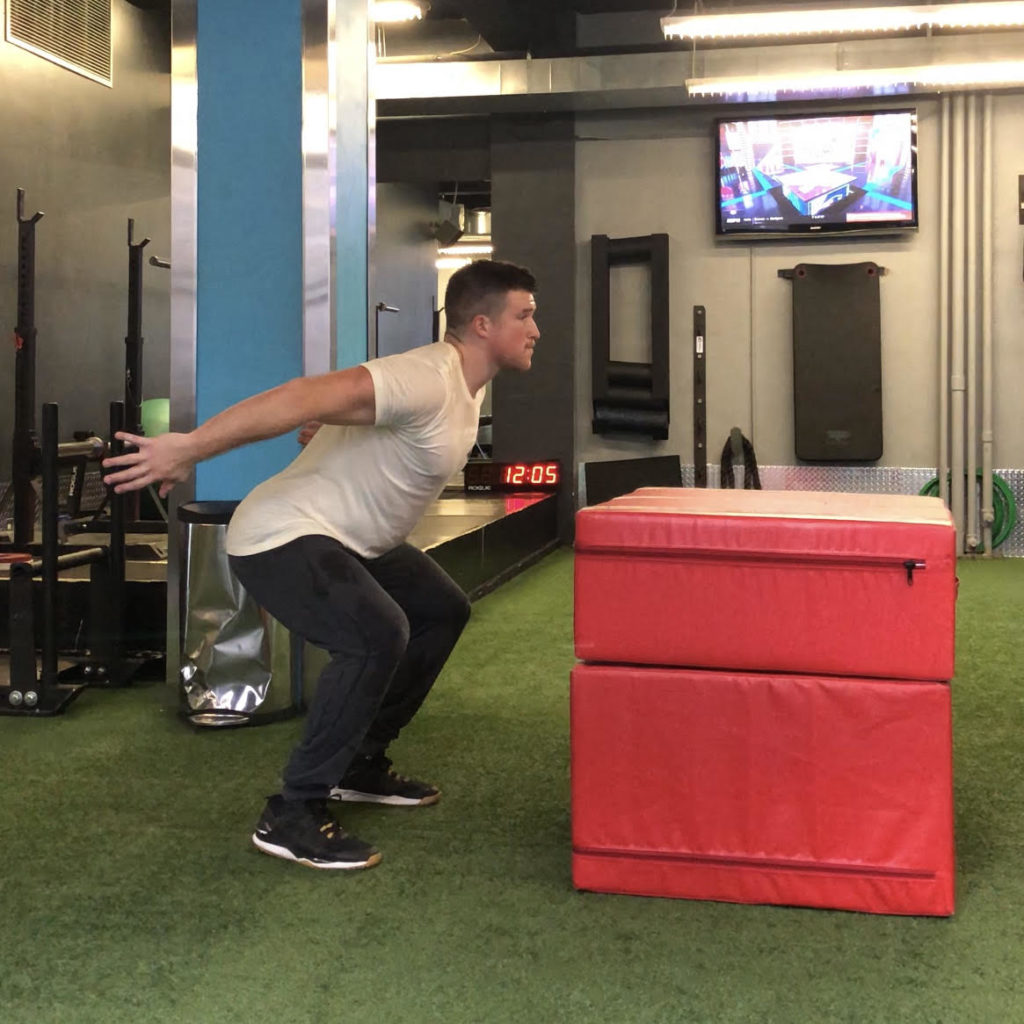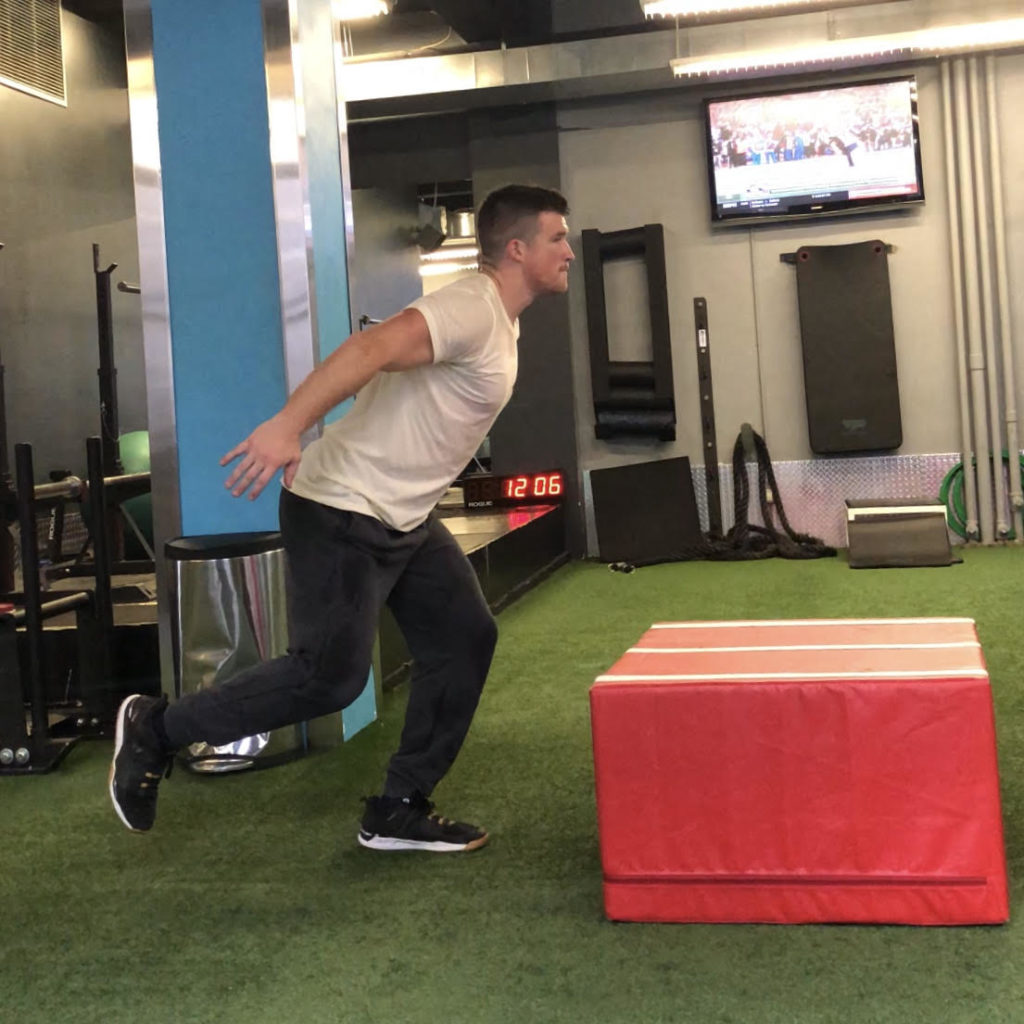The box jump is a plyometric exercise that is used by strength, power, fitness, and sports athletes to increase lower body power and explosiveness. While most of us are familiar with the box jump, it is important to understand the benefits and how to integrate these effectively within a training program. Note, that the below article is focusing on performing box jumps with the primary goal of increase force output, explosiveness, and athleticism, NOT simply performing AMRAPs of box jumps at submaximal weights for fitness WODs/purposes.
In this article we will discuss:
- The Importance of Box Jumps (for Strength, Power, and Sports Athletes)
- How to Integrate Box Jumps Into Your Program
- 10 Box Jump Variations You Should Try
Why Train Box Jumps (and other Plyometrics)?
Box jumps are a form of plyometric training, which has been shown to increase rate of force development and explosiveness. Strength athletes can utilize plyometric is to increase rate of force development to help accelerate heavy loads, specifically during phases where acceleration may drop (plyometrics to increase deadlifts strength, etc). Similarly, power athletes can use plyometrics to train the neurological and physiological systems for ballistic movements such as jerks, cleans, and snatches.

How to Integrate Box Jumps / Plyometrics Training Into Your Program?
Training plyometrics; such as the ten (10) box jump variations below, can be integrated in nearly all strength, power, fitness, and sports programs (and should be). Below are three main segments within a training program that plyometric work and the below box jump variations can be integrated to ensure effectiveness of training.
Warm-Ups
Adding box jumps and other plyometrics within you training program is beneficial for nearly every athlete, however doing them in a non-fatigued state is also key (at least for most individuals). While there are some methods that have plyometrics occurring during pre-exhausted states, it is generally recommended that lifters perform more neurologically demanding and power based movements before strength and conditioning segments. Warm-ups are a good place to program box jumping variations as they can be used to increase muscle excitation and force outputs and be done in non-fatigued state to effectively target the nuerological systems (rather than be limited by neural and muscle fatigue).
Post Activation Potentiation Training (PAP)
Post activation potentiation (PAP) training has been discussed in depth in previous articles, and has been shown to increase lower body power. This is done by pairing a strength movement done at relatively high intensity with a plyometric jumping movement (like the ten variations below). Be sure to read the above article for a full PAP description and example exercise of strength and jumping pairings.
Speed/Plyometric Days
Some coaches may opt to train speed and power-based movements on one day, as to target the power/acceleration defined systems in a non-fatigued state. This can be an effective way to build explosiveness during periods where an athlete is also working on building maximal strength.
Sets and Reps
It is recommended that for most maximal explosive repetitions, that total jumps per day are kept within the 8-15 range. Sets should be done between 1-3 repetitions. Note that these are my general recommendations IF your goal is maximal force output and explosiveness.
10 Box Jump Variations to Boost Strength, Explosiveness, and Athleticism
Below are ten box jump variations that can be used in most strength, power, and training programs to build overall leg explosiveness and increase general athleticism.
Countermovement Box Jump
The countermovement box jump is performed by having the lifter start in their standing position, with the hands straight overhead. The countermovement is when an athlete throws the hands down and back, towards the heels while simultaneously loading the hamstrings and hips as if they were going to perform a squat. Once they reach the end of the countermovement, they need to focus on explosively changing directions and jumping, minimizing the delay between the countermovement and the jump.
This box jump variation can enhance a lifter’s rate of force development and increase neurological excitation aspects necessary for maximal recruitment and explosiveness.
Static Box Jump
Static box jumps are done to force a lifter to increase lower body explosiveness with minimal stretch reflex. In doing so, lifters must concentrically contract the quadriceps and glutes more forcefully. This is also a good variation to simplify the jumping movement, as greater amounts of coordination are needed during countermovement box jumps and other advanced variations.
To perform this, start in the squatted position, and pause for a few seconds. Once ready, explosively jump onto a box, landing in a ½ squat.

Seated Box Jump
Seated box jumps are a form of static box jumps, as the negate a lifter’s ability to utilize the trench shortening cycle. In doing so, the lifter increase concentric power of the quadriceps and glutes. This is also helpful for individuals who may have ranges of motion where they have sticking points and/or lack explosiveness.
To perform this, simply start by being seated on a box (of any height) and jump onto another, being sure to minimize any rocking to gain momentum.
Depth Drop
Depth drops are key plyometric variations to help lifter’s learn and reinforce proper landing mechanics and build stronger foundation for jumping. They are effective at increasing eccentric control and coordination of the hamstring muscles while increasing a lifter’s ability to promote higher amounts of force AND absorb more force safely (better landing positions).
To do this, have a lifter stand on a 12-18 inch box. When ready, step of the box and land onto both feet, absorbing one’s body weight with the leg muscles as the assume a squatted position.
Depth Drop to Box Jump
This is a combination of the depth jump and the countermovement box jump, and is highly effective for increasing ground reaction force. By combining the depth drop with the box jump, you allow a lifter to harness the increased kinetic energy from the eccentric loading of the movement and develop greater capacities to transition into the reactive and concentric phases of the jump. In short, this combination can increase jump height and take off velocities equating to a more explosive athlete.
Weighted Box Jump
Like most weighted exercises, the goal is to increase strength and force production. When we do weight plyometric activities like box jumps however, we must be aware of the fact the using too heavy of loads is counter-productive; as it can alter the jumping mechanics necessary to move explosively. That said, using a lightly weight vest (5-10 lbs) or simply holding a medicine ball in the front of the body can be more than enough loading to impact a lifter just enough to force them to produce more force into the floor without manipulating jumping mechanics/technique. Resistance bands and harnesses can also be used in weighted jumping situations, however this is not advised when pairing with box jumps (use only with weighted vertical and/or broad jumps for safety purposes).
Hurdle Hops to Broad Jump
Similarly to the box jump variation above, the hurdle hop to box jump has the lifter perform a series of moving jumps over hurdles (which can range from small shops to large hurdles) with a box situated at the end of the hurdles. When they approach the box, they are to react and jump vertically so that they land on the box. This can help a lifter increase rate of force production and ground reaction force, which is key for maximal explosiveness and elasticity.

Single Leg Box Jump (land on both feet)
Like most exercises, unilateral training is always important. The single-legged box jump is done by having a lifter jump off of one foot, either from a static or countermovement position, and land with both feet on the box. This is also referred to as a 1-2 Box Jump, meaning the lifter jumps off one foot and lands on two. Like the one-step approached box jump, coaches should be sure to have athlete train both legs equally.
1-Step Box Jump
One-step box jumps has a lifter approach the box jump by stepping into the movement, which allows for them to gain momentum as they approach the jump. This is done by taking one step with a lead foot, then stepping the back foot in line, going directly into a double leg takeoff. This is highly applicable for sports athletes who often jump while coming from a forward moving situations. When doing this, be sure to have the lifter switch lead legs as they approach the jumps to build symmetry between both sides of the body.
Broad Jump to Box Jump
This is another combination jumping exercise that combines a broad jump into a box jump. This is done by having a lifter start a few feet away from a box so that they can perform a broad jump, land near the box, and then go directly into that box jump. This is a good way to add variety and complexity to a jumping program, and can help to increase a lifter’s proprioception and both horizontal and vertical jumping abilities.
Want More Jumping Articles?
Check out the article below for more plyometric based exercises and workouts!